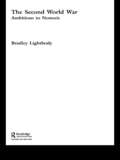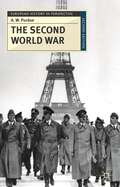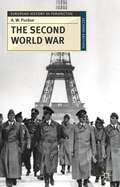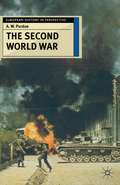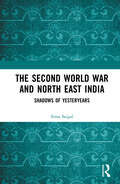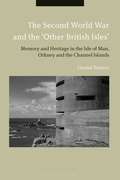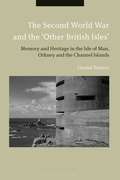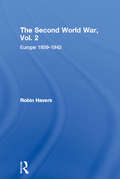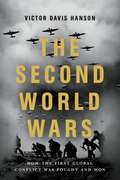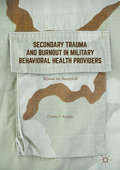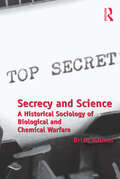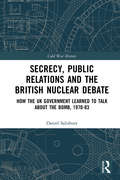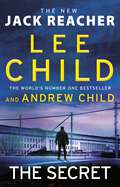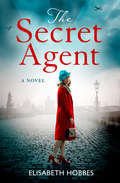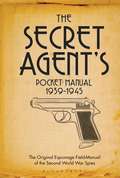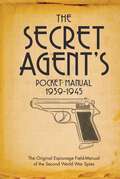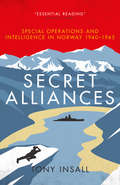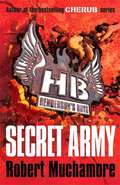- Table View
- List View
The Second World War: Ambitions to Nemesis
by Bradley LightbodyBradley Lightbody presents a fascinating and accessible history of the Second World War in its global context. Examining the war around general themes from ambition and advance, through expansion and containment, to rout and victory, The Second World War covers all the major theatres and events of the war. From the origins and background to the war to its aftermath and legacy, The Second World War covers: * the pre-war ambitions of Italy, Germany and Japan* the outbreak of the war in Poland* the 'Phoney War'* Blitzkrieg, the Fall of France and the Battle of Britain* Pearl Harbour* the war in North Africa and El Alamein* the final solution* D-Day, the liberation of Italy and deliverance from the concentration camps* the bombing of Hiroshima and Nagasaki. This book provides a comprehensive overview of the global ambitions and the global warfare that was the Second World War, making it essential reading for all students of twentieth century world history.
The Second World War: Ambitions to Nemesis
by Bradley LightbodyBradley Lightbody presents a fascinating and accessible history of the Second World War in its global context. Examining the war around general themes from ambition and advance, through expansion and containment, to rout and victory, The Second World War covers all the major theatres and events of the war. From the origins and background to the war to its aftermath and legacy, The Second World War covers: * the pre-war ambitions of Italy, Germany and Japan* the outbreak of the war in Poland* the 'Phoney War'* Blitzkrieg, the Fall of France and the Battle of Britain* Pearl Harbour* the war in North Africa and El Alamein* the final solution* D-Day, the liberation of Italy and deliverance from the concentration camps* the bombing of Hiroshima and Nagasaki. This book provides a comprehensive overview of the global ambitions and the global warfare that was the Second World War, making it essential reading for all students of twentieth century world history.
The Second World War (European History in Perspective)
by A. W. PurdueThe Second World War ended the Nazi attempt to establish Germany as the dominant power in Europe and the world; and Japan's aim of controlling South East Asia and the Pacific. It also resulted in the creation of two super-powers and led to the Cold War.A. W. Purdue provides one of the most concise yet comprehensive accounts of the entire course of World War Two, covering both the European and the Asian Pacific conflicts. Thoroughly revised and updated in the light of the latest scholarship, this second edition of an established text:* challenges accepted views and reassesses the war, rejecting the simplistic concept of a 'war against fascism'* discusses the historiography and critically analyses key themes and issues, as well as examining current debates* considers changes in popular attitudes to the Second World War.Ideal for students and general readers alike, this is an essential introduction to the causes, nature and significance of World War Two from the perspective of the twenty-first century.
The Second World War (European History in Perspective)
by A. W. PurdueThe Second World War ended the Nazi attempt to establish Germany as the dominant power in Europe and the world; and Japan's aim of controlling South East Asia and the Pacific. It also resulted in the creation of two super-powers and led to the Cold War.A. W. Purdue provides one of the most concise yet comprehensive accounts of the entire course of World War Two, covering both the European and the Asian Pacific conflicts. Thoroughly revised and updated in the light of the latest scholarship, this second edition of an established text:- Challenges accepted views and reassesses the war, rejecting the simplistic concept of a 'war against fascism'- Discusses the historiography and critically analyses key themes and issues, as well as examining current debates- Considers changes in popular attitudes to the Second World WarIdeal for students and general readers alike, this is an essential introduction to the causes, nature and significance of World War Two from the perspective of the twenty-first century.
The Second World War (European History in Perspective)
by A.W. PurdueThe Second World War ended the Nazi domination of Europe and Japanese aggression in the Asian Pacific but created two superpowers and another world crisis, the only recently concluded 'Cold War'. What were the causes of this, the second major conflagration in 20 years? How did the war progress, and could the Axis powers have succeeded? What were the consequences of a conflict that cost the lives of 53 million people, left many countries devastated and led to the creation of a bi-polar world?This study provides a fresh assessment of the entire course of World War II, covering both the European and the Asian Pacific conflicts, and argues that the combination of a hard-won victory and the onset of the Cold War provided a frozen perspective of 'winners' history', which has endured until the collapse of the Soviet Union and the reunification of Germany. AW Purdue reassesses the war, fully engaging with the latest scholarly research, and critically analyses the key debates, including whether the war was, along with World War I, a 'Thirty Years War', the responsibility of Adolf Hitler, the significance of ideology and the extent of opposition to Hitler's 'New Order'.
The Second World War and North East India: Shadows of Yesteryears
by Sima SaigalThis book discusses the untold story of North East India’s role during the Second World War and its resultant socio-economic and political impact. It goes beyond standard campaign histories and the epicentre of the Kohima-Imphal battlefields to the Brahmaputra and Surma Valley of Assam—the administrative and political hub of the region, where decisions on the allied war efforts were deliberated and effected right from the outset of the War. What happened in the entire region during the intervening years from 1939? What did the war mean for the people of Assam? How were resources from the region mobilized for the global war effort and how did people adapt, co-opt and survive during these tumultuous years? What was the response of the nationalist and provincial political leaders to the challenges and demands of war? How did the crisis of the 1942 war impact the region? First of its kind, this book investigates hitherto unanswered questions to offer an understanding of contemporary Assam and the North East, including discussions on the complexity of issues such as terrain, migration, taxation, profiteering, inflation, famine and food grain trade. With its lucid style and rich archival material, this volume will be essential for scholars and researchers of history, the Second World War, South Asian history, politics and international relations, colonial studies, sociology and social anthropology, and North East India studies as well as to the interested general reader.
The Second World War and North East India: Shadows of Yesteryears
by Sima SaigalThis book discusses the untold story of North East India’s role during the Second World War and its resultant socio-economic and political impact. It goes beyond standard campaign histories and the epicentre of the Kohima-Imphal battlefields to the Brahmaputra and Surma Valley of Assam—the administrative and political hub of the region, where decisions on the allied war efforts were deliberated and effected right from the outset of the War. What happened in the entire region during the intervening years from 1939? What did the war mean for the people of Assam? How were resources from the region mobilized for the global war effort and how did people adapt, co-opt and survive during these tumultuous years? What was the response of the nationalist and provincial political leaders to the challenges and demands of war? How did the crisis of the 1942 war impact the region? First of its kind, this book investigates hitherto unanswered questions to offer an understanding of contemporary Assam and the North East, including discussions on the complexity of issues such as terrain, migration, taxation, profiteering, inflation, famine and food grain trade. With its lucid style and rich archival material, this volume will be essential for scholars and researchers of history, the Second World War, South Asian history, politics and international relations, colonial studies, sociology and social anthropology, and North East India studies as well as to the interested general reader.
The Second World War and the 'Other British Isles': Memory and Heritage in the Isle of Man, Orkney and the Channel Islands
by Daniel TraversWhat is often held to be Britain's 'finest hour' – the Second World War – was not experienced so uniformly across the British Isles. On the margins, the war was endured in profoundly different ways. While D-Day or Dunkirk is embedded in British collective memory, how many Britons can recall that Finns were interned on the Isle of Man, that enemy soldiers developed British infrastructure in Orkney, or that British subjects were sent to concentration camps from Guernsey? Such experiences, tangential to the dominant British war narrative, are commemorated elsewhere in the 'other British Isles'. In this remarkable contribution to British Island Studies, Daniel Travers pursues these histories and their commemoration across numerous local sites of memory: museums, heritage sites and public spaces. He examines the way these island identities assert their own distinctiveness over the British wartime story, and ultimately the way they fit into the ongoing discourse about how the memory of the Second World War has been constructed since 1945.
The Second World War and the 'Other British Isles': Memory and Heritage in the Isle of Man, Orkney and the Channel Islands
by Daniel TraversWhat is often held to be Britain's 'finest hour' – the Second World War – was not experienced so uniformly across the British Isles. On the margins, the war was endured in profoundly different ways. While D-Day or Dunkirk is embedded in British collective memory, how many Britons can recall that Finns were interned on the Isle of Man, that enemy soldiers developed British infrastructure in Orkney, or that British subjects were sent to concentration camps from Guernsey? Such experiences, tangential to the dominant British war narrative, are commemorated elsewhere in the 'other British Isles'. In this remarkable contribution to British Island Studies, Daniel Travers pursues these histories and their commemoration across numerous local sites of memory: museums, heritage sites and public spaces. He examines the way these island identities assert their own distinctiveness over the British wartime story, and ultimately the way they fit into the ongoing discourse about how the memory of the Second World War has been constructed since 1945.
The Second World War, Vol. 2: Europe 1939-1943 (Essential Histories)
by Robin HaversWhile many of the participants were the same as the First World War, this conflict was far more than a re-match of 1914-1918. The Second World War was even more destructive than the first and the added ideological element meant that this war was far more cruel. This book details the first four years of the war in Europe. It discusses how and why Hitler's resurgent Germany plunged into war, and examines the German successes against Poland, France, and the Low Countries.
The Second World War, Vol. 2: Europe 1939-1943 (Essential Histories)
by Robin HaversWhile many of the participants were the same as the First World War, this conflict was far more than a re-match of 1914-1918. The Second World War was even more destructive than the first and the added ideological element meant that this war was far more cruel. This book details the first four years of the war in Europe. It discusses how and why Hitler's resurgent Germany plunged into war, and examines the German successes against Poland, France, and the Low Countries.
The Second World Wars: How The First Global Conflict Was Fought And Won
by Victor Davis HansonWorld War II sent the youth of the world across the globe in odd alliances against each other. Never before had a conflict been fought simultaneously in so many diverse landscapes on premises that often seemed unrelated. Never before had a conflict been fought in so many different ways - from rocket attacks on London to jungle fighting in Burma to armor strikes in Libya. It was only in time that these battles coalesced into one war. In The Second World Wars, esteemed military historian Victor Davis Hanson examines how and why this happened, focusing in detail on how the war was fought in the air, at sea, and on land-and thus where, when, and why the Allies won. Throughout, Hanson also situates World War II squarely within the history of war in the West over the past 2,500 years. In profound ways, World War II was unique: the most lethal event in human history, with 50 million dead, the vast majority of them civilians. But, as Hanson demonstrates, the war's origins were not entirely novel; it was reformulations of ancient ideas of racial and cultural superiority that fueled the global bloodbath.
Secondary Trauma and Burnout in Military Behavioral Health Providers: Beyond the Battlefield
by Charles C. BenightThis book provides an in-depth look at the complex clinical, individual, and organizational challenges that our clinicians face in treating our returning soldiers struggling with the aftermath of more than a decade of war. The author explores the confluence of factors that make this time in history a perfect storm for military mental health providers. The signature wounds of the Iraq and Afghanistan wars weave a tapestry of emotional turmoil with diffuse brain injury difficulties that challenge the very best clinicians under the best conditions. The author targets different pieces of the puzzle including the prevalence of secondary trauma and burnout, the organizational factors that promote negative clinician well-being, the creation and evaluation of an online social media based intervention for burnout, and a critical review of peer coaching.
Secrecy and Science: A Historical Sociology of Biological and Chemical Warfare
by Brian BalmerIt is no secret that twentieth-century Britain was governed through a culture of secrecy, and secrecy was particularly endemic in military research and defence policy surrounding biological and chemical warfare. More generally, it is hard to exaggerate the role of secrecy in all past biological and chemical warfare programmes and several recent historical surveys of biological and chemical warfare research have emphasised that all state sponsored programmes, together with sub-state organised activities, were cloaked in utmost secrecy. Of these research programmes, Britain carried out one of the most significant in scale and scope in the twentieth century. Yet, partly because of the secrecy surrounding the programme, there is still little academic literature on its historical development. Equally, and despite secrecy being a pervasive feature of past and contemporary societies, social scientists and historians have paid relatively little scholarly attention to the nature, mechanics and effects of secrecy, particularly with regard to secrecy in relation to the production and governance of science and technology. Drawing on classical sociological writing on secrecy by Simmel, Merton and Shils this groundbreaking book by Brian Balmer draws on recently declassified documents to investigate significant episodes in the history of biological and chemical warfare. At the same time, it draws on more contemporary perspectives in science and technology studies that understand knowledge and social order as co-produced within heterogeneous networks of 'things and people' in order to develop a theoretical set of arguments about how the relationship between secrecy and science might be understood.
Secrecy and Science: A Historical Sociology of Biological and Chemical Warfare
by Brian BalmerIt is no secret that twentieth-century Britain was governed through a culture of secrecy, and secrecy was particularly endemic in military research and defence policy surrounding biological and chemical warfare. More generally, it is hard to exaggerate the role of secrecy in all past biological and chemical warfare programmes and several recent historical surveys of biological and chemical warfare research have emphasised that all state sponsored programmes, together with sub-state organised activities, were cloaked in utmost secrecy. Of these research programmes, Britain carried out one of the most significant in scale and scope in the twentieth century. Yet, partly because of the secrecy surrounding the programme, there is still little academic literature on its historical development. Equally, and despite secrecy being a pervasive feature of past and contemporary societies, social scientists and historians have paid relatively little scholarly attention to the nature, mechanics and effects of secrecy, particularly with regard to secrecy in relation to the production and governance of science and technology. Drawing on classical sociological writing on secrecy by Simmel, Merton and Shils this groundbreaking book by Brian Balmer draws on recently declassified documents to investigate significant episodes in the history of biological and chemical warfare. At the same time, it draws on more contemporary perspectives in science and technology studies that understand knowledge and social order as co-produced within heterogeneous networks of 'things and people' in order to develop a theoretical set of arguments about how the relationship between secrecy and science might be understood.
Secrecy, Public Relations and the British Nuclear Debate: How the UK Government Learned to Talk about the Bomb, 1970-83 (Cold War History)
by Daniel SalisburyThis book constitutes an original archival history of government secrecy, public relations and the debate surrounding nuclear weapons in Britain from 1970 to 1983. The book contrasts the secrecy and near-silence of the Heath, Wilson and Callaghan governments on nuclear issues in the 1970s with the increasingly vocal case made for the possession of nuclear weapons by the first Thatcher government following a shift in approach in 1980. This shift occurred against a background of rising Cold War tensions and a growing public nuclear debate in the UK. The book seeks to contextualise and explain this transformation, considering the role of party politics, structures and personalities inside the government, and external influences: notably the role of investigative journalists and think tanks in cracking open official secrecy and demanding justification for Britain’s possession of nuclear weapons, and the peace movement in driving increasingly assertive public relations from 1980. The book draws on material from archives and interviews with key figures involved to provide an original and engaging account. It argues that this process of opening up saw significant disclosure of nuclear policy for the first time, and the most extensive public justification of the British nuclear capability to date, which has shaped public understanding of British nuclear weapons into the twenty-first century. This book will be of much interest to students of British politics, Cold War studies, nuclear politics and security studies.
Secrecy, Public Relations and the British Nuclear Debate: How the UK Government Learned to Talk about the Bomb, 1970-83 (Cold War History)
by Daniel SalisburyThis book constitutes an original archival history of government secrecy, public relations and the debate surrounding nuclear weapons in Britain from 1970 to 1983. The book contrasts the secrecy and near-silence of the Heath, Wilson and Callaghan governments on nuclear issues in the 1970s with the increasingly vocal case made for the possession of nuclear weapons by the first Thatcher government following a shift in approach in 1980. This shift occurred against a background of rising Cold War tensions and a growing public nuclear debate in the UK. The book seeks to contextualise and explain this transformation, considering the role of party politics, structures and personalities inside the government, and external influences: notably the role of investigative journalists and think tanks in cracking open official secrecy and demanding justification for Britain’s possession of nuclear weapons, and the peace movement in driving increasingly assertive public relations from 1980. The book draws on material from archives and interviews with key figures involved to provide an original and engaging account. It argues that this process of opening up saw significant disclosure of nuclear policy for the first time, and the most extensive public justification of the British nuclear capability to date, which has shaped public understanding of British nuclear weapons into the twenty-first century. This book will be of much interest to students of British politics, Cold War studies, nuclear politics and security studies.
The Secret: Jack Reacher, Book 28 (Jack Reacher #28)
by Lee Child Andrew ChildChicago. 1992. A hospital patient wakes to find two strangers by his bed.They show him a list of names and ask a simple but impossible question. Minutes later he falls to his death from his twelfth-floor window - a fall which generates some unexpected attention.That attention comes from the Secretary of Defense, who calls for an inter-agency task force to investigate. Jack Reacher, recently demoted from Major, is assigned as the Army's representative. If he gets a result, great. If not, he's a convenient fall guy.Reacher may be an exceptional military investigator, but office politics aren't what gets him up in the morning. As he races to identify a cold-blooded killer and uncover a secret that stretches back 23 years, he must navigate around his new partners.Will Reacher bring the bad guys to justice the official way . . . or his way?PRAISE FOR THE JACK REACHER SERIES'There's only one Jack Reacher. Accept no substitutes.' MICK HERRON'Jack Reacher is today's James Bond, a thriller hero we can't get enough of.' KEN FOLLETT'Everyone needs to kick some butt sometimes, even if it's just imaginary.' JOJO MOYESPRE-ORDER YOUR COPY NOWAlthough the Jack Reacher novels can be read in any order, The Secret is the 28th book in the internationally bestselling series.
The Secret: A captivating read which will keep you guessing!
by Jennifer WellsA tightly woven story full of secrets and lies with a breathtaking finale. London 1920 – Troubled young dancer, Lily, is invited to remote Elmridge House, home of the wealthy theatre benefactor Dr Cuthbertson to escape her troubled past. An isolated guest room and a surprise pregnancy leave her longing to return to the stage and her London life. She soon discovers that Elmridge House is not all that it seems – the house holds secrets which make it difficult for her to leave. Missensham 1942 – Young nurse Ivy Watts is called out to a patient at Elmridge House, home of the aloof Mrs Cuthbertson and reclusive Dr Cuthbertson. Ivy is entranced by the opulence of the house and its glamorous past, but when she tells her mother about Mrs Cuthbertson, her mother becomes fearful and forbids her from returning to the house. What secrets does Elmridge House hold? And why does Ivy's mother live in fear of the mysterious Mrs Cuthbertson? Perfect for the fans of Lesley Pearse and Susan Lewis.
The Secret Agent
by Elisabeth HobbesMy name is Sylvie Duchene and I am a dancer. There is no network. I am just a dancer. I know nothing. Please…I swear it…
The Secret Agent's Pocket Manual: 1939-1945
by Dr Stephen BullMost wars have had some element of espionage and subterfuge, but few have included as much as the Second World War, where the all-embracing nature of the conflict, new technology, and the battle of ideologies conspired to make almost everywhere a war zone. The occupation of much of Europe in particular left huge areas that could be exploited. Partisans, spies and saboteurs risked everything in a limbo where the normal rules of war were usually suspended. Concealment of oneself, one's weapons and equipment, was vital, and so were the new methods and hardware which were constantly evolving in a bid to stay ahead of the Gestapo and security services. Silent killing, disguise, covert communications and the arts of guerrilla warfare were all advanced as the war progressed. With the embodiment and expansion of organisations such as the British SOE and the American OSS, and the supply of special forces units which operated behind enemy lines, clandestine warfare became a permanent part of the modern military and political scene. Perhaps surprisingly many of these hitherto secret techniques and pieces of equipment were put into print at the time and many examples are now becoming available. This manual brings together a selection of these dark arts and extraordinary objects and techniques in their original form, under one cover to build up an authentic picture of the Allied spy.
The Secret Agent's Pocket Manual: 1939-1945
by Dr Stephen BullMost wars have had some element of espionage and subterfuge, but few have included as much as the Second World War, where the all-embracing nature of the conflict, new technology, and the battle of ideologies conspired to make almost everywhere a war zone. The occupation of much of Europe in particular left huge areas that could be exploited. Partisans, spies and saboteurs risked everything in a limbo where the normal rules of war were usually suspended. Concealment of oneself, one's weapons and equipment, was vital, and so were the new methods and hardware which were constantly evolving in a bid to stay ahead of the Gestapo and security services. Silent killing, disguise, covert communications and the arts of guerrilla warfare were all advanced as the war progressed. With the embodiment and expansion of organisations such as the British SOE and the American OSS, and the supply of special forces units which operated behind enemy lines, clandestine warfare became a permanent part of the modern military and political scene. Perhaps surprisingly many of these hitherto secret techniques and pieces of equipment were put into print at the time and many examples are now becoming available. This manual brings together a selection of these dark arts and extraordinary objects and techniques in their original form, under one cover to build up an authentic picture of the Allied spy.
Secret Alliances: Special Operations and Intelligence in Norway 1940–1945 – The British Perspective
by Tony InsallIn this extraordinary book, historian Tony Insall reveals how some of the most striking achievements of the Norwegian resistance were the detailed reports produced by intelligence agents living in the dangerous conditions of the country’s desolate wilderness.A definitive appraisal of Anglo-Norwegian WWII cooperation, Secret Alliances provides remarkable insights into the uniquely close political relationship that afforded powerful assistance for a successful resistance movement. Using previously unpublished archival material from London, Oslo and Moscow, Insall explores how SIS and SOE developed productive links with their Norwegian counterparts – and examines the crucial intelligence from the Security Service and Bletchley Park codebreakers who supported their sabotage operations.Offering dramatic details on operations such as gunnerside – which targeted the heavy water plant in Vemork in order to foil the Nazis’ plans to build an atomic bomb – and the sinking of the Tirpitz in November 1944, Secret Alliances is an authoritative new perspective on some of the most remarkable exploits of the Second World War.
Secret Army (Henderson's Boys Ser. #Bk. 3)
by Robert MuchamoreBritain, 1941. The government is building a secret army of intelligence agents to work undercover, gathering information and planning sabotage operations. Henderson's boys are part of that network: kids cut adrift by the war, training for the fight of their lives. They'll have to parachute into unknown territory, travel cross-country and outsmart a bunch of adults in a daredevil exercise. In wartime Britain, anything goes.
